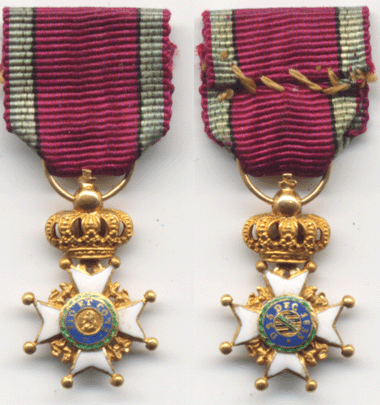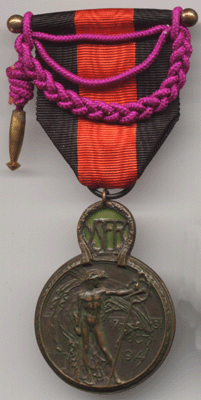
ErikMuller
-
Posts
316 -
Joined
-
Last visited
Content Type
Profiles
Forums
Blogs
Gallery
Events
Store
Posts posted by ErikMuller
-
-
Don't forget the little guys... miniatures

Here is my miniature: 11 mm wide

 0
0 -
@Hendrik: I got them in a lot once. Don't even know where to find them at the moment.
@Jef: I think Guy has some explaining to do
 Where do the other three Lanyards come from?0
Where do the other three Lanyards come from?0 -
Hello Jef & all,
When would those mixed ones have been created (date of decree) ? I fear they are fantasy ones but would love to be proven wrong !
On the other hand, in March 1953, the regulations on the Order of Leopold fourrag?re were changed considerably by creating three classes (and basically retroactive to WW2) :
1st class : three gilt thread stripes woven into the fourrag?re, ferret is gilt (for units with 16 citations minimum)
2nd class : three silver thread stripes woven into the fourrag?re, ferret is silvered (for units with 8 citations minimum)
3rd class : no interwoven stripes, ferret is bronze (for units with 4 citations minimum)
Cheers,
Hendrik
Sweet, didn't know that! Seems my Belgian fourrageres are incomplete then!
0 -
I just posted this as aditional information, not to say that someone is wrong or right. Sorry Hugh for note posting a translation. I felt that my english wasn't good enough to translate this piece!
OK, maybe wrong was the wrong word: misstaken is better! It clears up that what I thought to be a decoration actually was an umbrella
 0
0 -
I have no clear (or large) image of a soldier wearing the Red Lanyard (Rode Erekoord), so I can't see if there's brass at the end of them.
I know of at least two other Dutch 'unit' identity lanyards:
The Fuselierskoord (Fusilier Lanyard) of the Garderegiment Prinses Irene
The United Nations Lanyard (for UN Vets)
These two I have had in the past and were without brass.
0 -
Hey, sarcasm... at least that I understand

Rough translation, probably filled with misspellings:
It is possible that the object refered to as "Yellow Soeng" could be the sunscreen or "pajoeng". This pajoeng has the shape of a mushroom (in the native language "Soeng") and is often yellow in colour. In High Javanese this word is often pronounced as "songsong", which correctly pronounced could also be heard as as "soeng".
The pajoeng was the most seen mark for native civil servants. On the field of the pajoeng their rank was displayed by colours, stripes and knobs. Each pajoeng has a field ("latar"), on which is a knob with a starshaped item with pointy points (?) Both items are gilded. The stick on which the sun screen is placed was gold for the regents and black or white for the lower servants.
These pajoengs were abolished in 1904.
Since I thought the Yellow Soeng was a medal, Herr General cited this information to point me I was wrong (*wow*)
0 -
I think you are right. The soldiers of the Polish 1st Independent Parachute Brigade obtained the right to wear the Orange Lanyard in 1944 or 1945, while the banner of the Brigade was awarded with the Order of William by Queen Beatrix as late as in 2006. I saw the diploma of the award at the Polish Institute in London. This means that unlike the Franch or Belgian fourragere, which always comes with a decoration to a unit, the Orange Lanyard is a separate award.
What about the Red Lanyard? Isn't it the countarpart of the Orange Lanyard for peacetime operations?
Best regards,
Lukasz
No it is a completely different kind of award. It is awarded to individual NCO's and men for meritorious conduct. This can be performing better that to be expected, saving life, giving first aid to a fellow soldier of a civilian during difficult circumstances, etc.
I don't know when it was instituted, but the first mention of it I found dates back to 1967.
Cheers,
Erik
0 -
Well, I would like to see something more,
perhaps eric's "something small and nice"
Or don't you have something to show us, Chris???
Kind regards,
Jacky
That "small and nice" is an 8 mm gold miniature of the Sachsen-Ernestine House Order. It's currently boxed and awaiting the movers, I'm afraid I won't be able to get scans from most of my collection the next two months.
0 -
The Orange Lanyard is a unit verion of the Military Order of William. It looks quite simple. You can read more about it here.
I knew there was a reason why I never use Wikipedia: it's mostly wrong! And the guys filling it use pictures they don't have the copywright for it.
The Orange Lanyard was awarded to:
- the Divisional Colours of the U.S. 82nd Airborne Division (Which also got the MWO and the Resistance Commemorative Cross)
- the Divisional Colours of the U.S. 101st Airborne Division (Which only got the Resistance Commemorative Cross)
- IXth Army Air Force Troop Carrier Command
So nothing to do with the MWO!
0 -
The Orange Lanyard is a unit verion of the Military Order of William. It looks quite simple. You can read more about it here.
The Orange Lanyard is not the Red Lanyard. The Orange Lanyard was a unit award which is no longer awarded, the Red Lanyard is an individual award which is still awarded.
The Orange Lanyard has nothing to do with the Military Order of William. It was awarded in the fashion of the U.S. Distinguished Unit Citation.
0 -
If it's bright red, so it must be the lanyard for the Legion of Honor.
However, the Netherlands Army also has a red lanyard (just called Red Lanyard) awarded for meritorious acts by NCO and enlisted men. I have no clue how that one looks like off uniform.
Cheers,
Erik
0 -
Those miniature lanyards were unofficial, but they are seen quite often.
0 -
And of a Croix-de-Guerre 1914-1918 with a miniature lanyard for the same decoration.

 0
0 -
Here is a picture of the Yser Medal with a miniature lanyard for the Order of Leopold I.

 0
0 -
Sorry, but it seems to be too pink to be the L?gion d'Honneur. But, maybe it is the pic...
Ch.
It's the Belgian Fouragere for the Order of Leopold I.
0 -
Gentlemen,
A bar with some Lippe.
Nice to see a bronze medal of honor of the Family Order of Orange in a German group

Do you know who the owner is?
0 -
I can offer to do a W?rttemberg Military Merit Order roll. BUT before I start I need some guys who might want one!

A bit late for a reaction: but I would definitely want one!
0 -
One would not realize there is so much to publish on dutch orders and decorations!! What will his new 3 books be about?
He just published his book on the "Schutterij-ereteken" (Militia Decoration). Future books will be: "Medailles van de Maatschappij tot Nut van 't Algemeen" (Medals of the Society for Public Weal), "Medailles van de Maatschappij tot Redding van Drenkelingen 1767-1900" (Medals of the Society for the Prevention of Drowning) and the beforementioned book on the Family Order of Orange. He also has his manuscripts finished for the Order of Orange-Nassau (1892-2000) and Order of the Netherlands Lion (1815-2000).
I'm currently finishing my manuscripts on the "Medaille van het Rode Kruis" (Medal of the Red Cross) and the Naarder Eerepenning (Medal for the Siege of Naarden 1814).
0 -
7th row
2. French Korea Medal
0 -
6th row (Norwegian)
- War Cross
- Order of Saint Olav (Grand Cross?)
- Participation Medal
- War Medal
0 -
OMSA would publish it.
Not in Dutch they will ;-) And I don't think C.P. Mulder has the time to translate it into English, he's already working on three new books!
0 -
I just found a great Ordenspange in an old Carsten Zeige catalogue.
Lippe-Detmold / Denkmunze an der erstrittenen Thronanspruch 1905
Schaumburg / Goldene Verdienstmedaille 1893-1905
Detmold / Goldene Verdienstmedaille 1905-1918
Leopold-Orden Silbernes Verdienstkreuz
Sachsen / Silberne Friedrich-August-Medaille
Sachsen-Meiningen / Silberen medaille Hausorden Herzog Georg von Sachsen-Meiningen
Schaumburg / Silberen Verdienstmedaille
Niederlande / Silberen Verdienstmedaille des Hausorden von Oranien
Is it possible to name this bar? I would like to know why he got the Dutch award! I will post a scan tomorrow!
Roel,
This man cannot be more than a 'lakei' (sorry, don't have my dictionary at hand).
Unfortunately the manuscript for the Family Order of Orange lies still unpublished because the author can't find a publisher for it :-(
Cheers,
Erik
0 -
Third class St. Alexander ( commander grade ) always in green enamel. The higher & lower classes in white enamel. Hope it helps.
Just checked my very limited source on Bulgarian orders (a badly photocopied booklet by Militaria House Canada). I think you guys are right: it definitely looks like a Commander in the Order of St. Alexander. The things I though were swords, were actually the ribbons (?) from under the crown.
Thanks!
Now just to confirm those awards to H.W. Baron Taets van Amerongen van Woudenberg
 0
0 -
MANY thanks for the ?lberg list-- where exactly was that published?

The second Commander grade Order looks to me like a Bulgarian St. Alexander. I can't think of anything else likely which had "swords on ring" that way. Unfortunately the scan is too small, dark and blurry to be certain.
@ Sascha: I'm missing 14 names :-)
@ Rick: I agree, but doesn't the Saint Alexander-order has white enamel? This one looks dark.
0


Supposedly Belgian and WW2 ...
in Northern European & Baltic States
Posted
Have you tried Loek J.? He is the unofficial walking Belgian medal encyclopedia, erm... walking unofficial Belgian med... walking Belgian unofficial medal encyclopedia